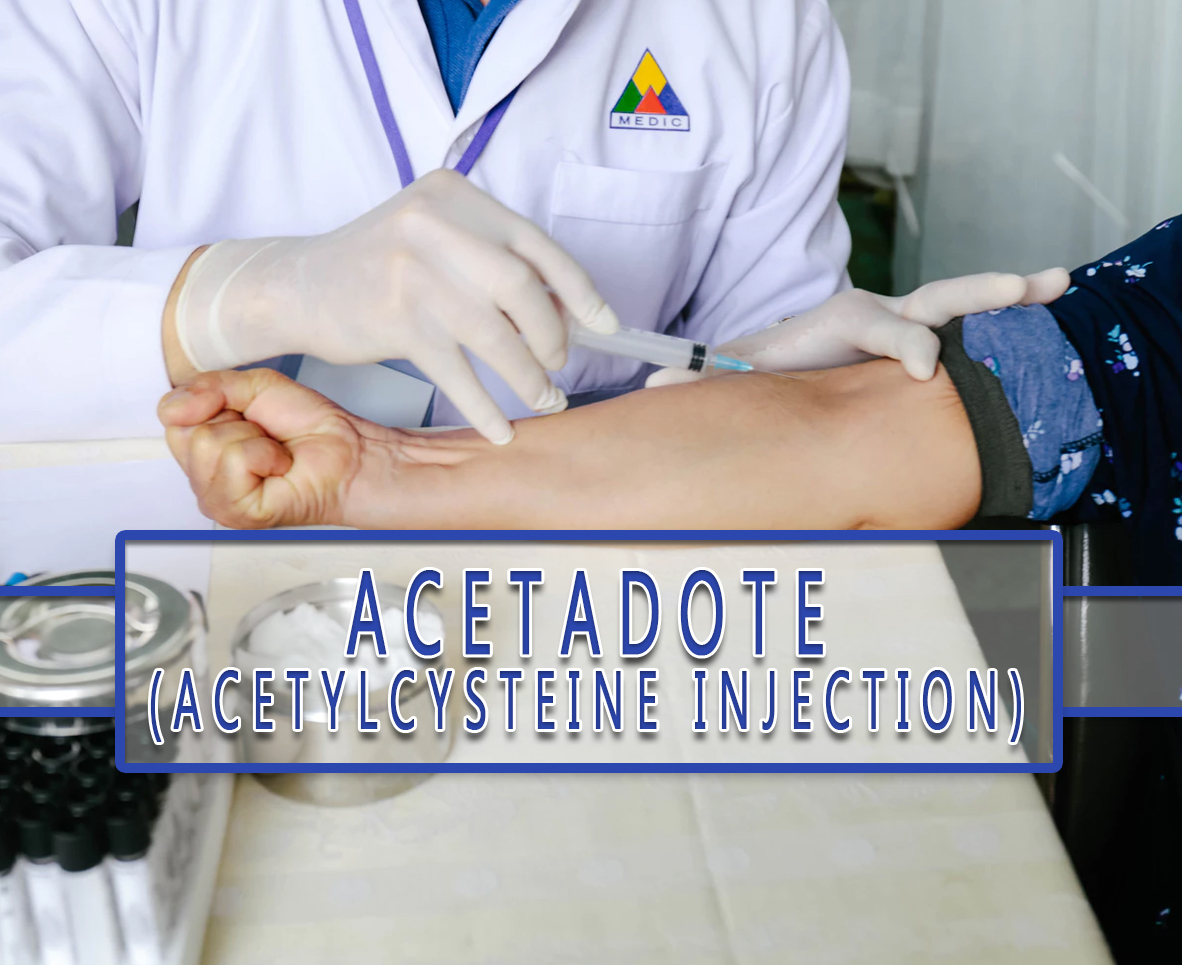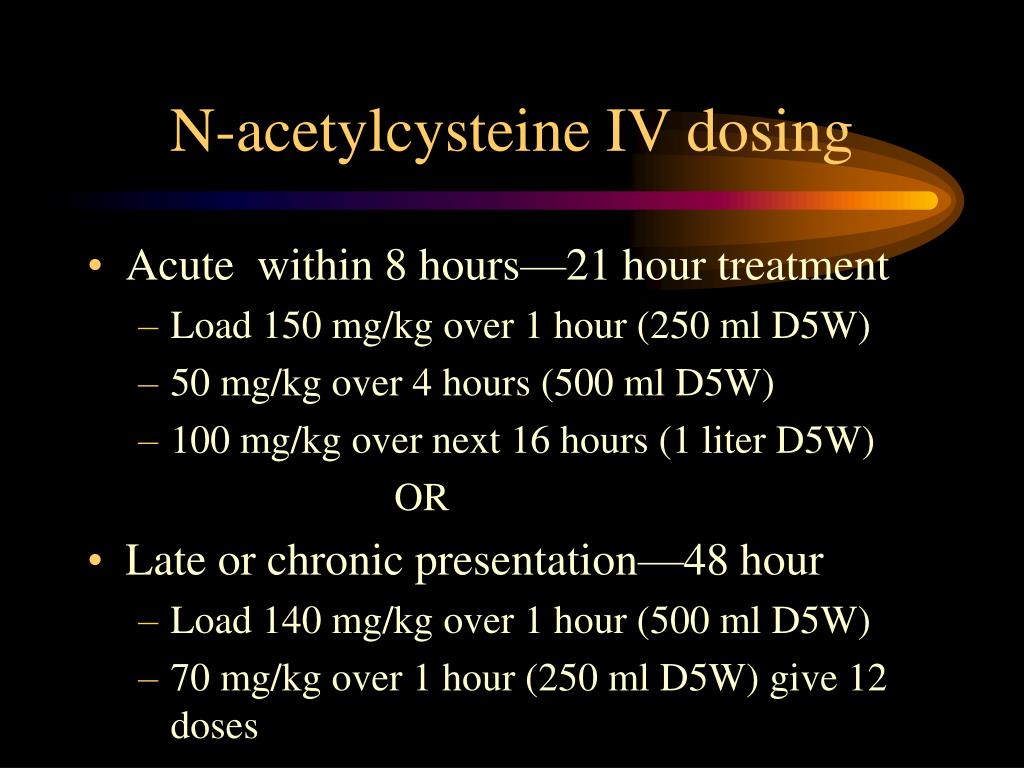

Note: It is highly recommended to consult with a poison control center or medical toxicologist when considering the discontinuation of acetylcysteine prior to the conclusion of a full course of therapy. Third dose: 100 mg/kg infused over 16 hours.Second dose: 50 mg/kg infused over 4 hours.Loading dose: 150 mg/kg infused over 1 hour.21-hour regimen: Consists of 3 components.Repeat dose if emesis occurs within 1 hour of administration.Maintenance dose: 70 mg/kg every 4 hours for 17 additional doses.Treatment should begin within 8 hours of ingestion or as soon as possible after ingestion. NAC augments sulfation, NAC2 is a glutathione (GSH) precursor, NAC3 is a GSH substitute, and NAC4 improves multiorgan function during hepatic failure and possibly limits the extent of hepatocyte injury. NAC helps replenish glutathione stores to conjugate the toxic metabolite, and assists with other routes of liver metabolism as well.The non-toxic route of APAP metabolism gets saturated in overdoses, which leads to the formation of the toxic metabolite NAPQI.Antidotal therapy with N-Acetyl Cysteine (NAC).Nausea, vomiting, acidosis, hepatic or renal failure.Activated charcoal may be useful if administered early on or if suspected co-ingestants.Generally not useful due to rapid APAP absorption.This patient plots above the “150-line” at 4 hours on the nomogram for her single ingestion acute overdose. SCr (Toxic APAP metabolites can also affect CYP enzymes in the kidney).If progressive hepatic failure, obtain LFTs every 12 hours.If lab testing shows progressive hepatic failure or continued detection of = continue NAC (this implies repeat testing).If is undetectable and ASTs are normal = NAC is unnecessary.If time of ingestion is unknown or if ingestion spans more than 24 hours: Screen with labs (APAP concentration, hepatic function tests, renal function tests, coagulation studies, blood gas), assess patient risk factors and clinical features.Remember, majority of APAP absorption occurs by 4 hours (this may not be true with overdose).ĭetermining Hepatotoxicity Risk if Nomogram Isn’t Applicable.The treatment line starts at 150 mcg/mL at 4 hours post-ingestion.

Serum concentrations above the treatment line indicate the need for N-acetylcysteine (NAC) therapy.The Rumack-Matthew nomogram is used to determine the risk of APAP-induced hepatoxicity after a single acute ingestion only(not for chronic or repeated ingestions).Rumack-Matthew Nomogram for Acetaminophen 1 Obtain a 4-hour level (or later, up to 24 hours) to get estimated peak absorption (that is, if time of ingestion is certain).įigure 1.Getting an APAP level 1 to 4 hours after ingestion may be helpful only to exclude ingestion of APAP (that is, if the level is zero).Stages of Acute Acetaminophen Poisoning 1,3 100 mg/kg/day over 72 hour period or greater.150 mg/kg/day or 6 g/day (whichever is less).(Note: more likely to see doses >200 mg/kg cause toxicity).Chronic overdose occurs with repeated supratherapeutic ingestions (greater than an 8-hour period).Acute overdose is arbitrarily defined as an entire ingestion within a single 8-hour period.Examples include cough and cold products, migraine medications (which also could contain aspirin like Excedrin® Migraine), etc.This can be one of the causes for chronic APAP toxicities.Many OTC combination products contain acetaminophen! The time to peak may be extended by coingestion of opiods or anticholinergics.Therefore, one can assume for all ingested formulations (whether IR or ER), most APAP is absorbed at 4 hours.ER – majority is absorbed within 4 hours.IR – majority is absorbed within 2 hours.There are immediate- and extended-release formulations.Her weight is 54 kg.Ī cetaminophen (APAP) comes in different strengths and formulations. She complains of nausea and vomiting and admits this was an attempt to harm herself. Author: Maryam Abdrabbo, PharmD Candidate 2018 (Rutgers Ernest Mario School of Pharmacy, New Brunswick NJ), Cynthia Santos, MD (Assistant Professor Emergency Medicine, Medical Toxicology, Rutgers NJMS) // Edited by: Alex Koyfman, MD EM Attending Physician, UTSW / Parkland Memorial Hospital), and Brit Long, MD EM Attending Physician, San Antonio, TX)Ī 19-year-old woman is brought into the ED by family members after she reported ingesting 35 Tylenol tablets (Extra-Strength) 2 hours ago.


 0 kommentar(er)
0 kommentar(er)
